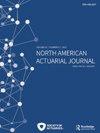On Fitting Probability Distribution to Univariate Grouped Actuarial Data with Both Group Mean and Relative Frequencies
IF 1.6
Q3 BUSINESS, FINANCE
引用次数: 2
Abstract
Many publicly available datasets relevant to actuarial work contain data grouped in various ways. For example, operational loss data are often reported in a grouped format that includes group boundaries, loss frequency, and average or total amount of loss for each group. The process of fitting a parametric distribution to grouped data becomes more complex but potentially more accurate when additional information, such as group means, is incorporated in the estimation process. This article compares the relative performance of three methods of inference using distributions suitable for actuarial applications, particularly those that are right-skewed, heavy-tailed, and left-truncated. We compare the traditional maximum likelihood method, which only considers the group limits and frequency of observations in each group, to two research innovations: a modified maximum likelihood method and a modified generalized method of moments approach, both of which incorporate additional group mean information in the estimation process. We perform a simulation study where the proposed methods outperform the traditional maximum likelihood method and the maximum entropy when the true underlying distribution is both known and unknown. Further, we apply the methods to three actuarial datasets: operational loss data, pension fund data, and car insurance claims data. Here we compare the performance of the three methods along with the maximum entropy distribution (under the traditional maximum likelihood and the modified maximum likelihood methods) and find that for all three datasets the proposed methods outperform the traditional maximum likelihood method. We conclude that there is merit in considering the proposed methods while fitting a parametric distribution to grouped data.具有群均值和相对频率的单变量分组精算数据的概率分布拟合
许多与精算工作相关的公开数据集包含以各种方式分组的数据。例如,操作损失数据通常以分组格式报告,其中包括组边界、损失频率以及每个组的平均或总损失金额。将参数分布拟合到分组数据的过程变得更加复杂,但当在估计过程中加入额外的信息(如组均值)时,可能会更准确。本文比较了使用适合精算应用程序的分布的三种推理方法的相对性能,特别是那些右倾斜、重尾和左截断的分布。我们将传统的极大似然方法与两种研究创新进行了比较:一种改进的极大似然方法和一种改进的广义矩方法,这两种方法在估计过程中都包含了额外的组均值信息。我们进行了模拟研究,当真实的潜在分布是已知和未知时,所提出的方法优于传统的最大似然方法和最大熵。此外,我们将这些方法应用于三个精算数据集:经营损失数据、养老基金数据和汽车保险索赔数据。在这里,我们比较了三种方法的性能以及最大熵分布(在传统的最大似然方法和改进的最大似然方法下),发现对于所有三个数据集,所提出的方法都优于传统的最大似然方法。我们得出结论,在拟合分组数据的参数分布时,考虑所提出的方法是有价值的。
本文章由计算机程序翻译,如有差异,请以英文原文为准。
求助全文
约1分钟内获得全文
求助全文

 求助内容:
求助内容: 应助结果提醒方式:
应助结果提醒方式:


